I have much to report on GG IV results so far, including updates on millipedes, whip scorpions, freshwater red algae (!) and other fascinating new island critters but Academy activity level has been very high since the team got back, and I have just returned from Capetown where I gave talk on the GG Island biodiversity. This week we welcomed Eden Maloney of the University of California at Los Angeles to the lab. Eden will be working all summer on the genetics of the São Tomé shrew, samples of which have been provided by our colleague, Ricardo Lima with kind permission from the STP Ministry of Environment.

Eden "Shrewster" Maloney (UCLA) examining her first shrews at the Academy. (phot. RCD)
In earlier blogs, we have posed the question: Is the shrew on Sao Tome, Crocidura thomensis really an endemic species, or was it introduced from elsewhere by man? Eden will be able to answer the question in a couple of months based on comparing the DNA sequences of our samples with related mainland species. The possibility exists that if native to São Tomé, this may prove to be the only endemic oceanic island shrew in the world! Followers of the blog will already know why this is biogeographically so unlikely.
I will update you on exciting GGIV findings in later blogs; right now I want to report on some marine activities that have just occurred since the GGIV team returned a couple of months ago. In reading the account below, bear in mind that the inshore marine organisms are just as isolated as are the terrestrial species; these are old, old islands both above and below the sea surface, and we must include marine critters adapted to the underwater parts of the islands as just as likely to have endemic species as those in the forests and other terrestrial habitats.
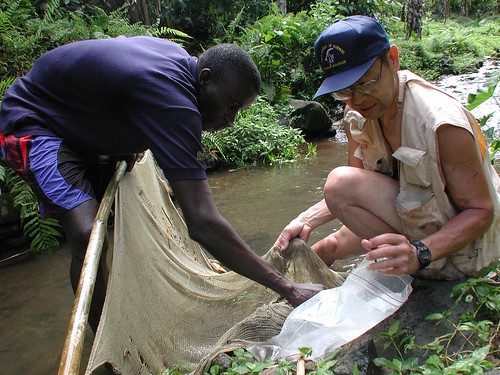 Quintino Quade and Dr. Tomio Iwamoto, seining on Sao Tome. [D. Lin phot. GG I]
Quintino Quade and Dr. Tomio Iwamoto, seining on Sao Tome. [D. Lin phot. GG I]
Readers of the blog will already be acquainted with Dr. Tomio Iwamoto, Chair of our Department of Ichthyology and veteran of GG I and GG II. During these first two expeditions, Tomio studied and seined almost all of the freshwater rivers and streams on both islands and co-authored two papers on the results; the first in 2006 was a study of the species of gobies that dominate the island freshwater environment on the islands, and the second was an update of the list of coastal marine fishes written with a number of authors in 2007. Much of our GG I and GG II material is in this work as Tomio also interacted with the local fisherman and the fish markets. This publication lists a total of 185 species with several not yet described.
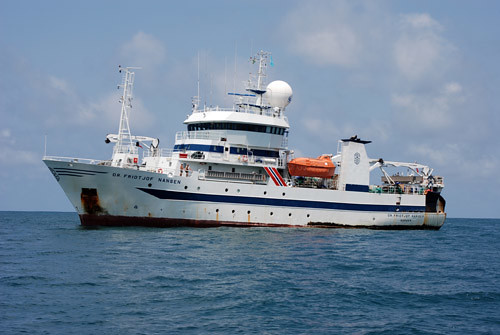
Norwegian Research Vessel, R/V Dr. D. Fridtjof Nansen [phot O. Alvheim, 2010]
Although he has done all of our freshwater island work, Tomio is actually a marine ichthyologist specializing in a deep-sea group called grenadiers, and he is a frequent participant on scientific trawling expeditions.
As luck would have it, shortly after the GG IV team returned to the Academy, Tomio joined the crew of the Norwegian research vessel Nansen, and although originally scheduled to trawl along the coast of Ghana the itinerary changed and the vessel actually worked the waters of São Tomé and Príncipe for two weeks. Timing could not have been better because about this time, here at the Academy I began receiving emails from friends on the islands about a mass die-off of the local pufferfish, known also as the Oceanic or Rabbit puffer. Apparently the southeastern beaches of São Tomé were covered with dead ones, and the local people were quite concerned. I was able to email Tomio on board the Nansen and the ship was in perfect position to look into the matter.
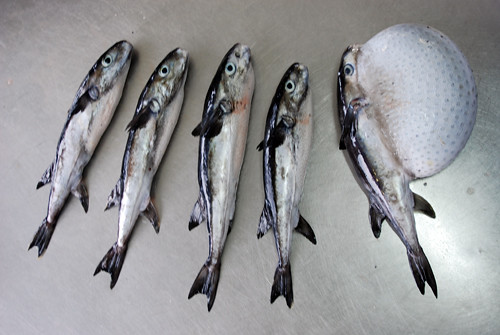 Oceanic or Rabbit pufferfish, Lagocephalus lagocephalus. [Phot. O. Alvheim 2010.]
Oceanic or Rabbit pufferfish, Lagocephalus lagocephalus. [Phot. O. Alvheim 2010.]
According to several staff of the Nansen, such die-offs have been seen before, especially off the coast of Gabon, south to northern Angola, but appear to have become somewhat regular since 2007, usually in March-May. The vessel monitors water salinity, current velocity and temperature at all transects trawled. None of the Rabbit puffers they studied showed any signs of disease or physical trauma; however, about 4 miles offshore of the town of São Tomé, they came upon a current boundary lined with floating dead puffers.
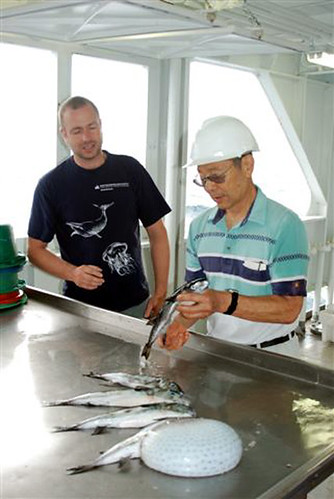
Jens-Otto Krakstad and Dr. Iwamoto examining dead puffers [Phot O. Alvheim 2010]
Usually such boundaries occur between bodies of water different in both salinity and/or temperature. In their report to the STP Fisheries, they consider the possibility that rapid changes in temperature/salinity could account for these die-offs, but so little is known of the oceanography of the two islands that a positive explanation is elusive.
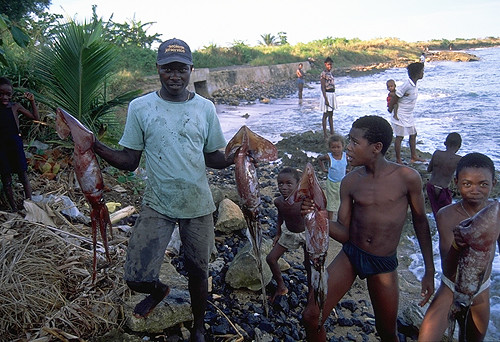
Giant squid (Lula) catch. Sao Tome northeast coast [ RCD phot. 2000]
It is curious that these die-offs seem to coincide with the annual appearance of large squid (called Lula). These are greatly prized by the locals who wade in the surf, catch them by hand and throw them onto the shore. We’ve eaten them—they’re good. But it is equally possible that the appearance of the large squid is the result of some sort of breeding activity and not related to changes in the water at all, nor correlated with the puffer die-offs.
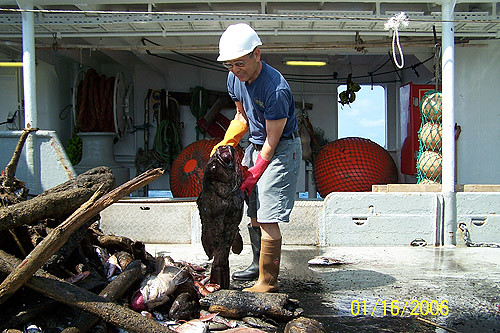 Tomio examining grouper, Sao Tome. [phot. O. Alvheim 2010]
Tomio examining grouper, Sao Tome. [phot. O. Alvheim 2010]
Shipboard life for a research ichthyologist is exciting (and exhausting) as one never knows what the next net will contain, and they are hauled in as often as every 4 hours, 24 hours a day! Tomio’s emails were delightful. Here is some fun stuff in his own words:
We made a so-so haul yesterday afternoon, coming up with nothing much different. There was a large sea cucumber that was caught--looked like a large loaf of bread with large blotches on the dorsum. I set it aside in a pan with plans to take a tissue sample and a patch of skin for Rich Mooi's [GG II] colleague, David Pawson………..
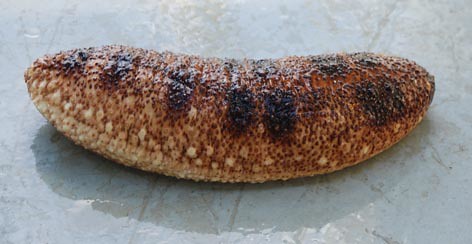
Unidentified sea cucumber aboard the Nansen [phot O. Alvheim]
After working up the catch, I brought the cuke into the wet lab and took my samples before going out on deck to work up the next catch. When I returned, I was startled when I discovered something thrashing about in the pan …. Lo and behold, it was a carapid, a pearl fish or fieraster, that lives within the holothuroid. Pearlfishes are freeliving or either parasitic or live as inquiline residents in many invertebrates, such as sea cucumbers, clams, tunicates, starfishes.

Unidentified Pearlfish or Feiraster [phot O. Alvheim 2010 ]
This represents just another of many new fishes recorded from STeP…. We caught an entirely different kind of pearlfish off Ghana…….All in all, the Nansen seems to have recorded at least fifty (50 !) species of fish never before recorded for the island coastal waters, including the first specimen of a fish called Carangoides bartholomaei ever taken in the eastern Atlantic.
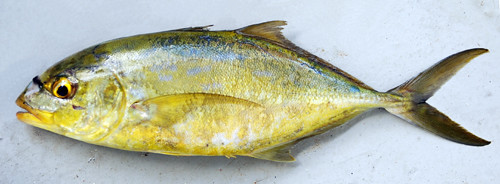 Carangoides bartholomaei- first specimen from the eastern Atlantic. [Phot O. Alvheim 2010]
Carangoides bartholomaei- first specimen from the eastern Atlantic. [Phot O. Alvheim 2010]
When I first visited the islands in 2000, I was invited to dinner at what I was told was the “best restaurant in town” called the Blue Container. I thought to myself, ”what a peculiar name for a restaurant” and remained somewhat mystified until we actually arrived, when I learned that that is exactly what it is: a light blue shipping container that each night opens up and barbeques fish! I am sure it has another name, but it is most famous as the Blue Container.
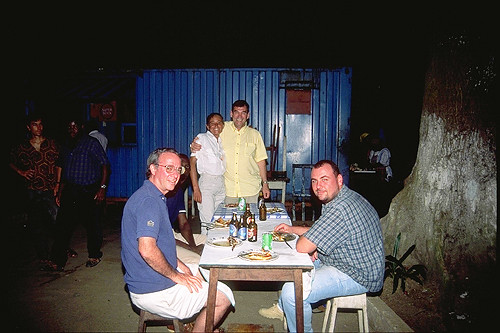
At the Blue Container: Ned Seligman (STePUP), T. D’Espiney (former ECOFAC director), me and MARAPA worker. [RCD phot 2000).]
The Blue Container specializes in grilled Flying gurnard, highly sought after and known locally as Con- con (for English speakers pronounced “kong kong”, but without the ”g”). The Con-con is inevitably served with breadfruit and marine snails.
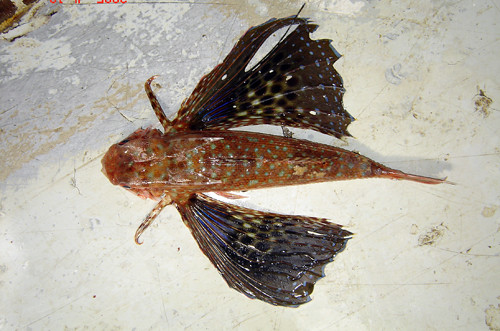
Flying Gurnard or Con-con, Dactylopterus volitans [Iwamoto phot. 2010]
The Con-con does not fly, of course. The name comes from the highly specialized wing-like pectoral fins; it apparently is a bottom dweller that sort of “walks” on these fins. Here is another excerpt from Tomio’s emails:
I now know why Con-con is so popular a fish in these islands: the water is full of them. I wish I had taken a shot of our first haul; pretty close to being entirely made up of [this species]!
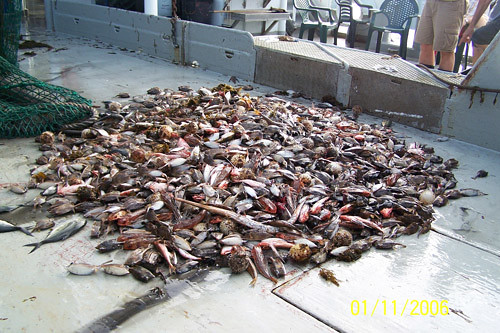
A typical trawl haul with a lot of Con-con [Phot O. Alvheim 2010]
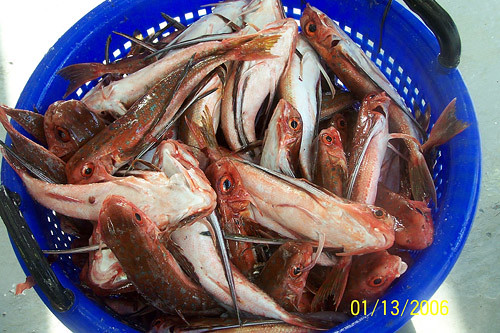 More Con-con [Iwamoto phot. 2010]
More Con-con [Iwamoto phot. 2010]
There is no question that such a survey is of enormous benefit to the Republic of São Tomé and Príncipe; knowing the actual makeup of the fisheries resources of their island can lead to more effective management, and members of the Department of Fisheries accompanied the Nansen throughout the survey.
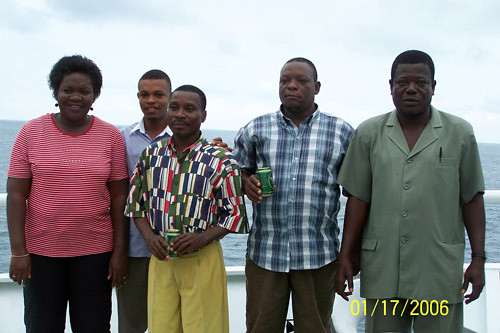 Staff of the STP Department of Fisheries [phot. O. Alvheim 2010]
Staff of the STP Department of Fisheries [phot. O. Alvheim 2010]
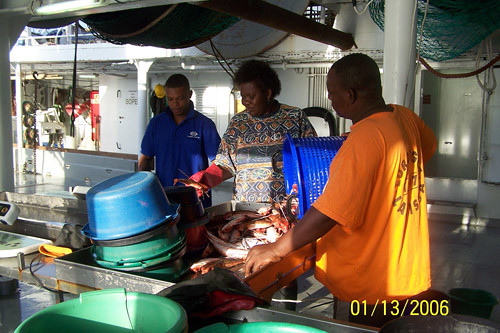 Fisheries staff measuring Con-con. [Phot O. Alvheim 2010]
Fisheries staff measuring Con-con. [Phot O. Alvheim 2010]
On this survey, many of the local fishermen benefitted directly! Here, again, is Dr. Iwamoto: We were off the northwestern tip [São Tomé] where we anchored and hung around overnight after setting out [off-shore] fish traps. This morning, the guys went out to retrieve them and couldn’t locate a one—taken by locals during the night.! That day, The STeP cruise leader, Jose Dias de Sousa Lopes and crew went onshore and made a deal with the local fishermen: leave our traps alone and we will give you our catch. Thereafter, the traps were remained in place, and the local fishermen paddled out to receive this unexpected bounty!
 Fishermen awaiting the Nansen catch. [Phot. O. Alvheim 2010]
Fishermen awaiting the Nansen catch. [Phot. O. Alvheim 2010]
 There IS such a thing as a freelunch! [Phot. O. Alvheim 2010]
There IS such a thing as a freelunch! [Phot. O. Alvheim 2010]
As a final note, Dr. Iwamoto emailed some comments about Príncipe that very much support some of my own conclusions from our work on the islands:
It seems obvious that Príncipe and São Tomé are under very different hydrographic regimes…….The waters around Príncipe lack the biomass one sees in places like Angola, but the overall size of the fishes caught is quite large, suggesting a pristine, little exploited population. Colors of fishes here also tend to be brighter, this according to one of the Norwegian biologists….
These statements reinforce the geological evidence that Príncipe is much older than the big island (twice as old in fact) and this is perhaps reflected in the age and stability of its fish populations.
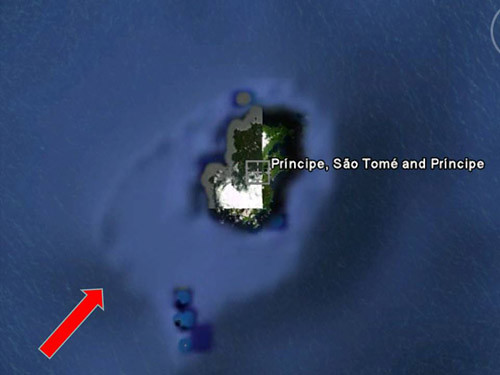 Satellite image of Principe. Arrow denotes predominent weather direction (RCD construct]
Satellite image of Principe. Arrow denotes predominent weather direction (RCD construct]
Viewed from above, one can readily see how large Príncipe must have been some 30 million years ago. The light blue areas are today at about 90 meters in depth but these margins are undoubtedly the original perimeter of the island at its earliest origins – it was probably larger than São Tomé is now. The predominant weather in the Gulf of Guinea is from the southwest [red arrow] and probably has been for millions of years. So one can see that the island has gradually eroded away from the southwest to northeast.
 Cross-section of island of Principe. [RCD construct]
Cross-section of island of Principe. [RCD construct]
In the above cross-section the part of old Príncipe that has worn away and is now under some 90 meters of water is beneath the blue arrow. In fact, the southwest exposures of Bioko, Príncipe and São Tomé are the steepest and most heavily eroded and on all three, this aspect of each of the islands is accessible only by boat.
Enough for now. Suffice to say that as I write, scientific colleagues at the Smithsonian Institution, Old Dominion University and the South African Institute of Aquatic Biology are describing at least five new marine fish species collected by the California Academy of Sciences Gulf of Guinea Expeditions.
The Parting shot.

Old fishin' buddies on Praia das Conchas, Sao Tome. Weckerphoto GG III
PARTNERS
We gratefully acknowledge the support of the G. Lindsay Field Research Fund, Hagey Research Venture Fund of the California Academy of Sciences, the Société de Conservation et Développement (SCD) and Africa’s Eden for logistics, ground transportation and lodging, STePUP of Sao Tome http://www.stepup.st/, Arlindo de Ceita Carvalho, Director General, and Victor Bomfim, Salvador Sousa Pontes and Danilo Barbero of the Ministry of Environment, Republic of São Tomé and Príncipe for permission to export specimens for study, the continued support of Bastien Loloum of Zuntabawe and Faustino Oliviera, Curator of the Herbarium at Bom Sucesso. Special thanks for the generosity of private individuals, George G. Breed, Gerry F. Ohrstrom, Timothy M. Muller, Mrs. W. H. V. Brooke, Mr. and Mrs. Michael Murakami, Hon. Richard C. Livermore, Prof. & Mrs. Evan C. Evans III, Mr. and Mrs. Robert M. Taylor and Velma and Michael Schnoll for helping make these expeditions possible. Our expeditions can be supported by donations to CAS - Gulf of Guinea Fund.